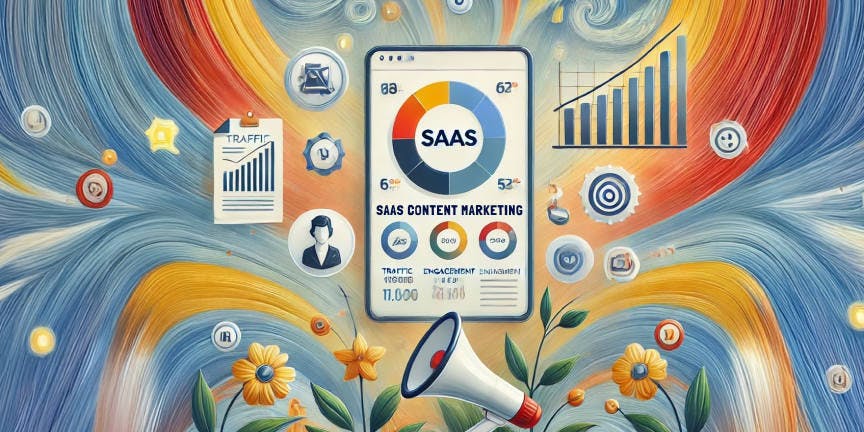Your SaaS content strategy might be strong—it helped you publish high-quality content and build credibility in your industry. But are you confident that it's generating the results you need?
Many SaaS marketers face the challenge of measuring content marketing success and understanding how well content resonates with their target audience. With countless metrics to track and analyze, it's easy to feel overwhelmed and unsure which ones truly reflect the effectiveness of your content marketing efforts.
This blog will focus on how to measure SaaS content marketing performance using key metrics. You will discover the most valuable metrics to assess the effectiveness of your content strategies.
What are Content Marketing Metrics?
Content is more than just information—it's a strategic asset that builds brand awareness, boosts online visibility, and drives qualified leads. Content marketing metrics are key indicators that help you evaluate the effectiveness of your SaaS content or assets.
Tracking metrics allows your SaaS marketing teams to:
- Measure the contribution of content marketing efforts to business growth.
- Identify which types of content resonate most with your target audience.
- Pinpoint strengths and weaknesses in your content strategy.
- Gain insights that support informed content decisions to achieve business goals.
Understanding these key metrics allows you to focus on creating engaging content that drives quality leads and reduces customer acquisition costs.
Now, let's learn about the key content marketing metrics to track.
14 Metrics to Track the Impact of Content Marketing Efforts
Content marketing success in SaaS goes beyond creating and publishing content. It’s about how effectively your content drives expected business outcomes. To measure this, you must define your goals and use the right metrics to track progress.
Before diving into critical metrics, let’s start with the foundation: setting clear, SMART goals that align with your SaaS content marketing strategy.
Set SMART Goals - But Why?
The SMART framework refers to specific, measurable, attainable, relevant, and time-bound goals for your SaaS content marketing. It ensures your business goals align with strategy and maximizes its impact on growth.
How to Set SMART Goals
1. Specific: Clearly define what you want to achieve with your content marketing. For example, increase website traffic through blog posts.
2. Measurable: Establish how you will measure progress. For instance, achieve a 20% increase in blog traffic over the next quarter.3. Attainable: Ensure your goal is realistic and achievable based on available resources. For example, create and promote four new blog posts per month.
4. Relevant: Align the goal with your broader business objectives, like improving lead generation or brand awareness. For example, drive qualified leads from blog traffic to increase conversions.
5. Time-bound: Set a clear timeline for achieving the goal. For example, organic traffic can be increased by 20% within 3 months.
Following the SMART framework helps you create clear, actionable goals to guide your content marketing strategy and measure its effectiveness.
Next, explore the key metrics aligned with different business goals to guide your content marketing efforts.
1. Traffic metrics
Organic traffic
This metric measures the number of visitors who visit your website organically through search engine result pages without any paid promotion. It reflects the quality and relevance of your content and delivers value to the target audience.
The more organic traffic your website receives, the higher your chances of attracting qualified leads and improving conversion rates.
For instance, if you started publishing blogs on your website a month ago and gained 1000 visitors, 1000 people found you on search engine pages. This demonstrates the quality of your content marketing efforts.
Want to Maximize Organic Traffic?
Let’s connect and create a SaaS content strategy that drives the maximum traffic your website deserves!
Search impressions
This metric tracks how often your content appears in search engine results, offering insight into its reach. It represents customers' first interaction with your SaaS product or website link on Google.
As your content ranks higher in search results, search impressions increase, indicating better visibility and engagement potential.
Tracking this metric helps you understand the initial touchpoints that attract visitors. It enables you to refine your TOFU (Top of Funnel) content strategies, align with search intent, and boost SERP rankings for greater visibility.
Top organic pages
Using this metric, you can identify what web pages or blog posts attract the most organic website traffic. The higher-traffic pages are considered to be the top organic pages.
Tools like Ahrefs help you find the top organic pages attracting the maximum traffic to your website. Additionally, they give you an idea of what type of content resonates well with your target audience and which topic they are interested in.

Tracking top-performing blog posts provides valuable insights, helping you optimize your content plan and focus marketing efforts on high-performing pages and topics.
2. Engagement metrics
Average time on page
This metric determines how long your visitors stay on a page or blog post. When you publish posts, ensure your content is engaging enough to keep visitors engaged. A higher average time on the page signals that your content resonates well with your audience's interest and is capturing their attention.
For SaaS companies, where products and features are complicated to explain, tracking this metric allows you to assess how effectively content captures and retains audience attention.
This data also evaluates which content types resonate most with your target audience, enabling you to focus on creating high-performing content.
Scroll depth
This key metric measures how far visitors scroll your blog post or page. It is measured as a percentage of the total page content. For instance, if your visitor scrolls half of the page and then abandons it, the scroll depth would be 50%.
Higher scroll depths often signify how visitors actively consume the content, whereas lower scroll depths may indicate disinterest or lack of engagement.
SaaS marketers and content creators can gain insights into which webpage sections capture users' attention and which areas need improvement or optimization.
Session duration
Session duration measures the total time users spend on a website in a single visit. It gives a clear view of how well your users engage with content. The longer session duration shows that your visitors find content engaging and informative, while the shorter sessions indicate the need for improvement.
To calculate session duration, divide the total time visitors spend on your site across all sessions by the total number of sessions. Ensure active time is included only and exclude idle periods when no user interaction is detected.
This metric helps SaaS businesses improve user engagement and retain potential customers, which can turn into Marketing Qualified Leads (MQL).
Bounce Rate
How much is your target audience engaging with your content and finding it interesting to check your other pages or blog content?
The answer to this question lies in measuring the bounce rate. This metric measures the percentage of visitors who land on the webpage but leave without interacting further or navigating to other pages on the site.
"Bounce off" suggests that your content needs to be more engaging to retain customers. However, it can also indicate that your content provided the exact solution your audience was looking for. As a result, visitors may have no reason to explore other site pages.
When your high bounce rate means the content is performing well, consider additional metrics like Conversion Rate or Time Spent on the Page to assess effectiveness.
Formula:

Based on data from Databox, the average bounce rate for SaaS companies is 48.24%. However, a reasonable bounce rate should be around 40% or lower. If it's higher than 60%, it indicates the need to reassess your content marketing strategy. Focus on improving content quality to make it valuable for visitors to stay engaged.
3. Conversion metrics
Conversion Rates
This metric acts as a barometer to measure the effectiveness of SaaS content in converting visitors into paying customers. It determines how well your content drives actions, like signing up for a free trial or subscribing to your SaaS product.
The conversion rate measures the number of people who convert into leads and sales through various marketing content, such as email newsletters, blogs, and landing pages.
The calculation of the conversion rate is quite simple, and here is the standard formula:

SaaS marketers and content experts can improve conversion rates by creating concise, easy-to-read content. Additionally, content should be created that makes users feel joy and anticipation and encourages conversions. Consider adding clear Calls-to-Action (CTA) to convert them into potential customers.
Click Through Rate (CTR)
Regarding content marketing for SaaS, CTR serves as a key performance indicator that reveals the true impact of your content. It shows the percentage of users who click on a specific link compared to those who viewed your content.
This metric helps you determine how irresistible and on-point your content truly is, giving you a clear picture of its relevance and appeal. The more people click on your listing in the SERPs, the more Google will assume it is an excellent answer to the search term.
Since every search engine aims to provide the searcher with the best answer to their question, they will rank you higher.
The formula to calculate the CTR is:

- Number of clicks: The total number of times users clicked on your link or content.
- Number of impressions: The total number of times your content was viewed.
The higher CTR indicates that the content resonates well with the audience, and the lower CTR signals that your headlines or calls-to-action (CTAs) need improvement. Use CTR to compare different content or CTAs and measure content elements performing well in capturing attention and user engagement.
4. Search Visibility
Keywords ranking
Your SaaS solution has excellent features, and your website has content that offers value and meets the audience's interests.
However, none of these are visible when your target audience searches for solutions online. This may be because your SaaS content is not ranking for the right keywords, making the best content unappreciated.
Tracking keyword rankings shows how many keywords make your content visible in the competitive search engine market. Each keyword that climbs higher in the SERPs signals increased brand visibility, attracting clicks and driving potential customers ready to convert.
Additional key strategies to improve keyword ranking:
- Analyze your competitor's keywords: When you monitor competitors, keep track of their keywords to discover opportunities and identify gaps in your content marketing strategy.
- Align with user search intent: Ensure your SaaS content addresses user search queries effectively. When your intent-aligned keywords rank high in SERPs, it signals your content's relevance and quality.
- Include geo-targeted keywords: If your SaaS targets specific regions, track local keyword performance to enhance visibility in those markets.
- Monitor trends: This is the most overlooked strategy but an important one. Analyzing trends and fluctuations in ranking helps you understand content effectiveness and improve marketing strategies.
SERP ranking
Search Engine Results Page (SERP) ranking indicates where your website or blog appears (at which position) in search engine results for specific queries.
The higher your content ranks, the greater its visibility, impressions, and clicks. This metric is a key indicator of your brand's ability to attract and engage potential customers through organic search.
For example, when a customer searches for "best CRM software," an authoritative website like PC Mag ranking first shows that its content effectively meets user intent and provides value.

To monitor and improve your SERP rankings, create content that aligns with user intent, answers specific queries, and provides actionable insights.
Additionally, you can optimize content for featured snippets and add questions from "People Also Ask" sections to claim valuable real estate in SERPs. Ensure that you regularly update and improve content effectiveness.
Backlinks
High-quality backlinks from reputable and authoritative websites act as endorsements for your website's credibility and authority in the eyes of search engines. These "votes of confidence" improve your website's ranking potential and signal to search engines that your content is valuable and trustworthy.
Tracking your backlinks provides crucial insights into which websites find your content valuable enough to link to. It also shows that your audience sees your content as engaging and valuable—so much so that they recommend it to others.
Focus on earning backlinks from high domain authority websites ensures your SaaS content marketing efforts contribute to long-term organic growth and better search visibility.
Boost Brand Authority with Quality Backlinks
We develop marketing strategies to secure high-quality backlinks that enhance your rankings and drive targeted traffic. Schedule a consultation today!
5. Social metrics
Social engagement
Tracking likes, shares, comments, and other social media interactions clearly shows how your audience reacts to your content. High engagement rates indicate that your content resonates with viewers, sparks conversations, and drives interest.
For SaaS businesses, this can mean your posts successfully highlight product value, educate your audience, or address their pain points.
These social engagement metrics allow you to identify content formats or topics that perform best. They measure customer engagement with your content and guide you through creating a social media marketing strategy focusing on audience preferences and interests.
Critical practices to improve social engagement:
- Create shareable content: Develop visually appealing, informative, or entertaining content like videos, infographics, memes, and guides that resonate with your target audience.
- Use compelling CTAs: Add clear, comprehensive CTAs encouraging likes, shares, or comments, such as asking for opinions or feedback.
- Time content strategically: Set the timing of posting on social media. You can post when your target audience is most active to maximize visibility and interaction.
- Include video and live content: Platforms like LinkedIn and YouTube favour video content, which drives higher engagement than static posts.
Mentions and Shares
Monitoring how often your content is mentioned or shared on social platforms reveals its reach and influence. Mentions show your brand is gaining recognition in industry conversations, while Shares indicate that users find your content valuable enough to recommend it to others.
This KPI highlights influential audiences or brand advocates who share or mention your social media content. Once you discover that your SaaS content engages existing and new customers, your content marketing strategy will work effectively and successfully.
To increase mentions and shares, create content around current industry trends or challenges that prompt users to tag others and share with their network.
Tools to Measure Content Marketing Success
Whether increasing organic traffic, lead generation, or improving conversions, having the right tools to measure content success is critical to optimizing your marketing strategy. This section will explore powerful tools to gather insights to fine-tune your content marketing efforts.
Let's dive in and discover how these tools can boost your content marketing success.
1. Google Analytics
Google Analytics is one of the best analytics tools for tracking site visitors and measuring content performance. It can identify which content drives engagement and where visitors drop off.
Evaluate the content based on scroll depth, session per duration, engagement, and website traffic through each content piece.
You can also analyze content engagement by demographics, geography, and device usage to tailor future content to your audience.

2. Ahrefs
This tool allows you to track how your target keywords rank over time and identify which type of content contributes to those rankings.
This platform provides insights into the number and quality of backlinks your content earns and which content drives more traffic based on geographical locations.
You can also check the SERP ranking of each piece of content to determine its search performance.

3. Google Search Console
Using GSC, you can track the clicks, impressions, and click-through rates (CTR) from each content and landing page. This allows you to find the search queries driving traffic to your web pages and optimize them if they are underperforming.
Additionally, you can check whether your content is indexed correctly and visible on search engines. Detect and resolve technical SEO issues, such as crawl errors or slow page speed that impact your content's visibility.

4. Surfer SEO
Surfer SEO helps measure and enhance SaaS content marketing effectiveness through data-driven optimization. Its Content Score evaluates how well your content aligns with top-ranking pages, while Keyword Optimization ensures balanced usage for better rankings.
The SERP Analyzer reveals competitor strategies, and the Content Editor offers real-time SEO guidance during writing. Surfer's Audit Feature revitalizes underperforming content by identifying gaps and suggesting updates.

Evaluate and Optimize Your SaaS Content Marketing Strategy
A content marketing strategy needs constant evaluation and optimization to stay effective. Tracking these basic metrics allows your SaaS business to understand audience preferences, identify gaps, and adapt to market trends.
It enables you to refine your content strategy, driving organic traffic and generating leads. You can also focus on high-value content, lowering acquisition costs and enhancing brand loyalty.
Without ongoing optimization, your marketing efforts risk becoming outdated. Refine your strategy as a priority to stay competitive and achieve maximum impact.
Ready to make content work for you? Let's create a strategy that delivers results!
Want to Enhance Your Content Marketing Strategy?
We will optimize your content marketing strategy that drives traffic, generates leads, and boosts conversions. Let’s connect!
FAQs
What is a KPI in SaaS?
KPIs (Key Performance Indicators) are quantifiable metrics that help businesses measure their success in achieving specific objectives. In SaaS, KPIs typically align with growth metrics like revenue, customer acquisition, and retention.
What are the six measures of success in content marketing?
Success in content marketing is typically measured through metrics such as organic traffic, engagement, lead generation, conversions, social engagement, and overall ROI.
How do I measure the ROI of my SaaS content marketing efforts?
Return on Investment (ROI) is calculated by comparing the revenue generated from content-driven efforts to the costs of creating and distributing the content, helping assess profitability.
What should be the first step in developing a content marketing strategy?
The first step in developing a content marketing strategy is defining clear goals. Identify what you want to achieve for your SaaS business, whether it's increasing brand awareness, generating leads, or boosting engagement.



